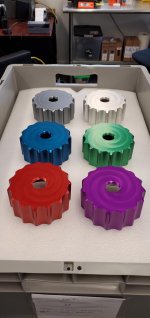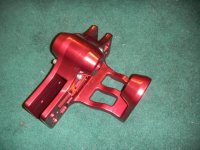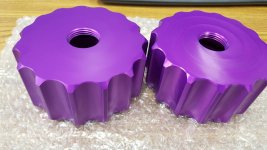Matt,
if it is the same bar they were cut out of and were on the same rack, then the difference is in thickness, the lighter part will have less oxide thickness, darker one - more, and it might be due to poor contact for the lighter part, I looked again at that photo and it seems they were racked where the red arrows point - on a threaded hole, it is always risky due to anodic layer growing perpendicularly into the material, so a 60 degree wedge shape, if the rack is touching it on the peak, will eventually have oxide grow below it and the part will lose electrical contact which will stop the oxide growth (and the thickness there was will reduce slightly due to sulfuric acid eating it away).

Electrolite in the bath is agitated with air or other means of mixing it to make sure the heat generated by the current flowing through the part is carried away and extracted via chiller, if not done properly, and the tank is deep enough, you may get that the top of the rack is anodizing in a warmer electrolite than the bottom of the rack - this again will affect the density of the oxide and consequently the dye absorbtion (and leakage during sealing), other issue with agitation is that poorly racked (not securely held) parts (especially if they are larger) may loose contact to the rack due to the part being moved around with the agitated electrolite, this might be your case if they racked those parts only on that short/small thread there.
there are really too many factors that can have big effect on how the dyed work comes out at the end, and without knowing more about the process there would be too much speculation to figure out what went wrong exactly
Here is a picture showing what I'm seeing lately - the undyed parts are supposedly all from the same batch of 6082, notice the yellowish hue to the few parts on the left, and there was no loss of contact or anything like that - it is clearly different material stock (if it even is indeed 6082), and this showed only coming out of the anodizing bath because I went for max thickness (28-30 micron in my case) for best durability, and all of them dyed charcoal black without any difference at all, but if it was some light dye - there might have been differences, not as great as with the 2 blue parts, but still.

Orange Vise, good luck with bringing the process in house and have it run reliably... unless you get someone with a LOT of experience, you'll run into the same problems sooner or later, anodizing is a very simple thing on paper, making 10 or even 50 parts look the same is quite trivial, making 500 with less that couple percent failure rate and then making another 500 look the same few months later - much more complicated, even if you control all the regular variables in your anodizing line, you'll still be subject to differences in the material batch that you just recently bought, and there can be quite significant effects even from getting material that is within specification of the alloy, but the alloying elements just happened to be in the minimum range for one batch and maximum for the other - and you'll get those gray and yellow parts I showed previously - there are ways of dealing with this though - that is where the experience will come in
edit:
here is another one defect that everyone will try to attribute to anodizing - it is sometimes called "bar end defect", when extruder doesn't cut out the start/trail end of a billed being extruded and just sells you all of it as the same material:

the red arrow points to hint - the "spot" in the center of the part, you can follow this "spot" through the part - this part happened to be hollow from the bottom and one could clearly see how this "spot" grows into the "ring" visible on the part at the top of the picture, I could actually line them up in the order they were cut from the bar... and this section of the extruded bar also anodizes to a visibly darker shade of gray - that difference between the 2 parts at the bottom is not an "illusion" - the left one is quite a bit more grayer that the right (the photo actually didn't show it as well as if you held them in hand next to each other)











